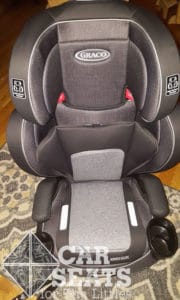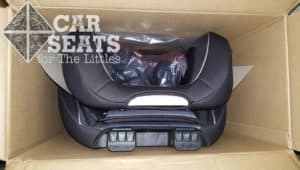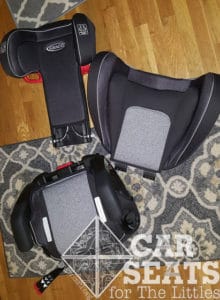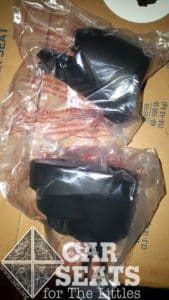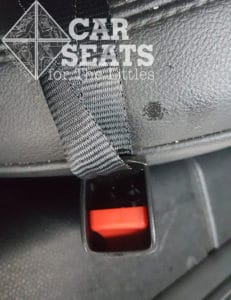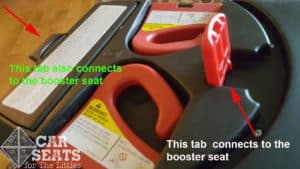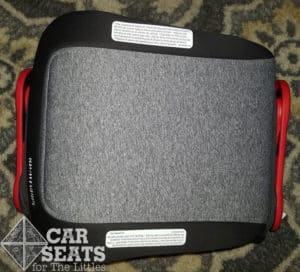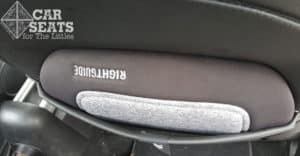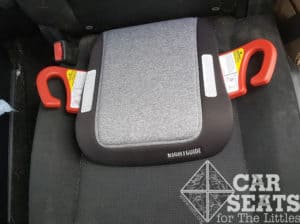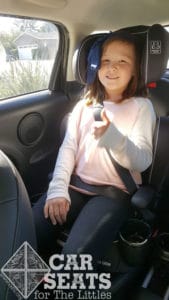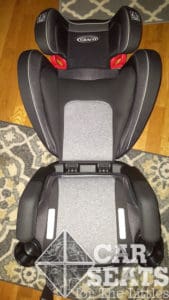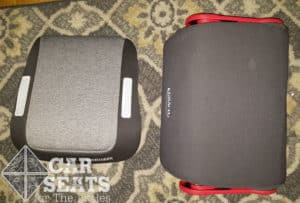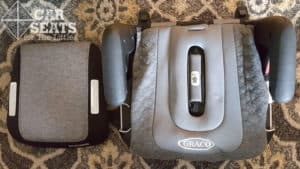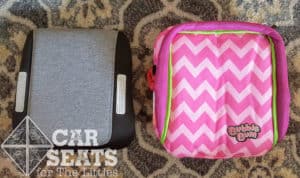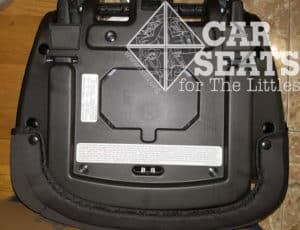Graco’s TurboBooster family of booster seats has expanded once again! Please join me in welcoming the TurboBooster Grow with RightGuide to the family. This high back booster converts to a lightweight backless booster seat that has a surprise inside! The RightGuide is described as a “seat belt trainer,” that lifts out from the backless portion of the booster to become a highly portable belt positioner.
CSFTL Quick Stats
- Weight range high back mode: 40-100 pounds
- Weight range backless mode: 40-110 pounds
- Height range high back and backless modes: 43-57 inches tall
- CSFTL recommends that children be at least 5 years old before moving to a booster seat.
- RightGuide weight range: 50-120 pounds
- RightGuide height range: 43-60 inches tall and at least 5 years old
- Expiration: 10 years from date of manufacture
Measurements
- Top shoulder belt guide position: 20 inches with RightGuide attached, 20.5 inches with RightGuide removed
- TurboBooster Grow width at widest point (cupholders): 19 inches
- TurboBooster Grow seat weight (with RightGuide attached), high back mode: 8 pounds
- TurboBooster Grow seat weight (with RightGuide removed), high back mode: 7 pounds
- TurboBooster Grow seat pan depth, high back mode: 13.5 inches
- TurboBooster Grow seat weight (with RightGuide attached), backless mode: 4 pounds
- TurboBooster Grow seat weight (with RightGuide removed), backless mode: 3 pounds
- RightGuide weight: roughly 1 pound
- RightGuide width at narrowest point (back of the seat pan): 9 inches
- RightGuide width at widest point: 12 inches
- RightGuide seat pan depth: 12 inches
Features
- Unique, easy to remove premium lower anchor connectors
- RightGuide seat belt trainer separates from the seat to be a highly portable booster seat
- High back and backless modes can be used with or without the RightGuide seat belt trainer
Assembly Required
The TurboBooster Grow ships in 3 main pieces, with the required cupholders in a separate bag. If you’ve read any of my reviews in the past, you may recall that review dog Leroy loved helping me assemble review seats. I’m so sad to tell you that he passed away this summer and I’m now heartbreakingly free to assemble seats without his dedicated assistance.
The headrest snaps into the back portion — this is a one time assembly. Once the back portion is assembled, lay the entire back portion flat, then slide the two hooks at the bottom onto the corresponding spaces on backless portion of the seat. Push down until the hooks snap into place, then move the back portion upright.
Once assembled, the TurboBooster Grow weighs in at a very reasonable 8 pounds.
Extra Padding
Our TurboBooster Grow includes a rather robust piece of extra padding on the back. The manual lists this padding as optional so it can be used anytime your young passenger finds it comfortable. Our primary model found this padding very comfortable.
Cupholders
The TurboBooster Grow includes two dishwasher-safe cupholders. One is slightly larger than the other but both are adequate to hold drinks and small furry friends.
Lower Anchors
The seat includes premium, push-button style lower anchors that are a little different from the lower anchor connectors we know. Instead of the entire button being pressed to release them, there’s an easy-release button that releases with just a finger. This sounds like a small thing but it made getting the TurboBooster Grow in and out of my vehicle a snap!! I’d love to see this style of lower anchors on other car seats and boosters seats.
Installation with Lower Anchors
The lower anchor connectors aren’t required for use — they hold the unoccupied booster seat in place in the event of a crash the same way a vehicle seat belt does. To ready the seat for use, lift the lever just above the lower anchor webbing on the front of the booster (the webbing has white arrows on it), then pull the lower anchor connector from the back of the seat while holding the lever down. Click the connector onto the lower anchors in the vehicle, then pull the webbing until it’s tight.
Setup without Lower Anchors
If your vehicle doesn’t have lower anchors or you’d rather buckle the empty booster when it’s not in use, the already fairly painless setup takes one fewer step. Just set the TurboBooster Grow on the vehicle seat, then thread the vehicle seat belt through the shoulder belt guide if it’s in high back mode. If it’s in backless mode, pull the vehicle seat belt out just a bit, then set it in front of the lap belt guide.
The lower anchor connectors are connected to the seat via some webbing that runs underneath the bottom of the baseless portion of the booster. They’re not accessible from outside the seat so if they get twisted, there’s no easy way to untwist them. I mention this because ours got twisted during the review process.
Overall Width
At 19 inches across, the TurboBooster Grow is on the wider side of booster seats. It’s unlikely that it’s a great option for three across situations.
Releasing the RightGuide
The RightGuide arrives attached to the backless portion of the TurboBooster Grow via a red tab that folds back into the RightGuide and a black tab at the back of the RightGuide. To release it, press the button on the front edge of the booster and the RightGuide will pop up. Then, lift it out of the booster seat.
Once it’s removed from the TurboBooster Grow, fold the tab on the RightGuide’s bottom back under the seat, and it’s free to carry another passenger or be tucked into a backpack.
Fit to Child
RightGuide
This is probably the part of the review that you’re waiting for so we’re putting it at the top of the Fit to Child section.
The first thing I noticed about the RightGuide is that it’s small. I absolutely know that the smallness is a selling feature but even with that, it’s narrow at the back. The type of older child who we’d like to see riding in something like the RightGuide is likely to have a rump that’s large enough to spill over the sides of the RightGuide, making it a fine option for shorter rides or unexpected situations.
However. The RightGuide is small enough and flat enough to fit into the pocket of my vehicle seat. It also tucks nicely into a backpack or other smallish bags that a booster rider might carry. At about 1 pound, it’s light enough that most carpoolers can carry it in such a bag or backpack without issue.
RightGuide Setup and Use
Setting up the RightGuide is pretty simple. Just unfold the belt guides from the bottom of the RightGuide and set it on the vehicle seat. Here you can see how darn small it is compared to my vehicle seat!
The belt guides are fairly large so it’s pretty easy for my kiddo to use. It also includes a shoulder belt guide adjuster that tucks into the bottom of the RightGuide. The manual stores on the bottom of the RightGuide.
RightGuide Vehicle Seat Belt Fit
9 Years Old
The main thing we’d like to see in a product like the RightGuide is for the vehicle seat belt to fit the child correctly. A booster seat’s primary and most important job is to position the vehicle seat belt over the 3 strongest points of the child’s body — across both hips and across the center of the collarbone.
We do want to emphasize that the RightGuide has a 50 pound minimum weight for use.
The RightGuide does that for our 9 year old model. She weighs 80 pounds and is 52 inches tall. That solid belt fit makes the RightGuide a great carpool option because it offers the same consistent vehicle seat belt fit that we know and love from the TurboBooster family of products and it’s easy enough for the child to set up and use. I wouldn’t say that it’s as comfortable as a larger booster seat (though it is reasonably well padded) with a wider seating area, but in a pinch? It’s a great option.
High Back Mode with RightGuide Attached
9 Years Old
This model is 9 years old, 52 inches tall, and wears a size 10 in most clothing. She’s at the top end of the height range for this booster in high back mode. The extra padding behind her back and the two cupholders made this seat a quick fan favorite!
High Back Mode without RightGuide Attached
5 Years Old
This model is 5 years old. He weighs 41 pounds and is 44 inches tall. He usually rides in a harnessed car seat but he was happy to check out the TurboBooster Grow for us. The belt fit on him is excellent — the vehicle seat belt lays across his hips and across the center of his shoulder. He found the seat very comfortable.
9 Years Old
Removing the RightGuide adds about .5 inches of height in high back mode. My 9 year old model also found the booster quite a bit more comfortable without the RightGuide.
The seat belt geometry in my new-to-me vehicle, a 2011 Mini Countryman, is kind of unique. The vehicle seat belt is mounted directly behind the vehicle seat, not on the pillar of the car’s frame. This means the vehicle seat belt tends to fit slightly differently than it does in other vehicles. For us, it means that this model gets to ride in a high back booster for a while yet because the shoulder belt guide fit is better with a fixed shoulder belt guide. It’s also helped her remain in the correct position when she’s sleeping in the car.
Converting to Backless Mode
Converting the TurboBooster Grow from high back to backless mode is the same process as converting other TurboBoosters. Set the booster on a flat surface, then hold the backless portion down while pushing the back portion away from you. Once the booster is flat, lift the back portion off of the backless portion and store it with your possibly embarrassingly large pile of car seats and car seat parts.
Fit to Child
Backless Booster Mode
Without Shoulder Belt Guide
Here again is our 9 year old model. She remains 52 inches tall and wears a size 10 clothes. The backless mode fit her reasonably well but once again, my car’s configuration made for a bit of a challenge. The shoulder portion of the vehicle seat belt is sliding off her shoulder so I wouldn’t say this is a good fit.
Important Note: this less-than-stellar vehicle seat belt is more of an issue with my vehicle than with the booster seat itself.
With Shoulder Belt Guide
Given the challenges we encountered with the vehicle seat belt fit in my vehicle, I asked my model to try the fit with the attached shoulder belt guide. This piece of equipment is attached to the seat and stores in a handy compartment on the back of the booster. Adding the shoulder belt guide placed the vehicle seat belt right over the center of her shoulder so in this case, the belt fit was good with the guide in use.
My model is very much her own person and she’s not a fan of this guide so we went back to high back mode for the rest of the review period.
Size Comparison
The RightGuide is small. I’ll illustrate that smallness by comparing it to Graco’s other carpool booster seats. First up, here’s the RightGuide next to a Graco Turbo Go. The RightGuide is smaller than the folded Turbo Go.
Here’s the RightGuide next to our family’s favorite portable booster seat: the TurboBooster TakeAlong. Since that TakeAlong came into our lives, it’s seen A LOT of action. We’ve taken it on trips, it goes on playdates, and sometimes hangs out in my trunk so I’m ready to drive other kiddos when needed. Here’s our well-loved TurboBooster TakeAlong next to the much tinier RightGuide.
The BubbleBum inflatable booster seat is a longtime favorite carpooling option. When inflated, the BubbleBum is a smidge bigger than the RightGuide.
Important Information: Where to Find
RightGuide
FAA Approval: the RightGuide is not approved for use on aircraft because, like all booster seats, it requires a lap and shoulder belt. However, the RightGuide is pretty darn portable and would fit in many a backpack or carryon bag. The label prohibiting airplane use is on the underside of the RightGuide.
Date of Manufacture: the RightGuide has a 10 year lifespan. The date of manufacture label is on the bottom of the RightGuide, underneath one of the red belt guides.
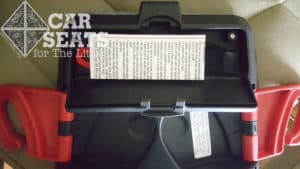 Manual Storage: the RightGuide’s manual (which is basically a pamphlet) stores on the bottom of the RightGuide.
Manual Storage: the RightGuide’s manual (which is basically a pamphlet) stores on the bottom of the RightGuide.
Shoulder Belt Guide Adjuster: the RightGuide’s shoulder belt guide adjuster is attached to the seat. It stores in the same compartment on the bottom of the RightGuide as the manual.
TurboBooster Grow
FAA Approval: the TurboBooster Grow and RightGuide are not approved for use on aircraft because, like all booster seats, they require a lap and shoulder belt. However, the RightGuide and the backless TurboBooster Grow are pretty darn portable and would fit in the overhead bin so they’d be ready for use upon arrival. The label prohibiting airplane use is on the bottom of the backless portion of the seat.
Date of Manufacture: both seats have a 10 year lifespan. The date of manufacture label is on the bottom of both the TurboBooster Grow and on the RightGuide.
Manual Storage: the TurboBooster Grow manual stores on the bottom of the backless portion of the TurboBooster Grow and the RightGuide manual (which is basically a pamphlet) stores on the bottom of the RightGuide.
Overall Thoughts
It’s no secret that we’re fans of the TurboBooster and that that love has grown to include the TurboBooster family of products as that product line has grown. Adding the extremely portable and well-fitting RightGuide to a well-featured, lightweight, reasonably priced high back booster adds an important carpool option to an already solid booster seat.
Giveaway!
Our friends at Graco are giving away one TurboBooster Grow to a reader from the United States. Read our Terms and Conditions, then enter for your chance to win!
a Rafflecopter giveaway

